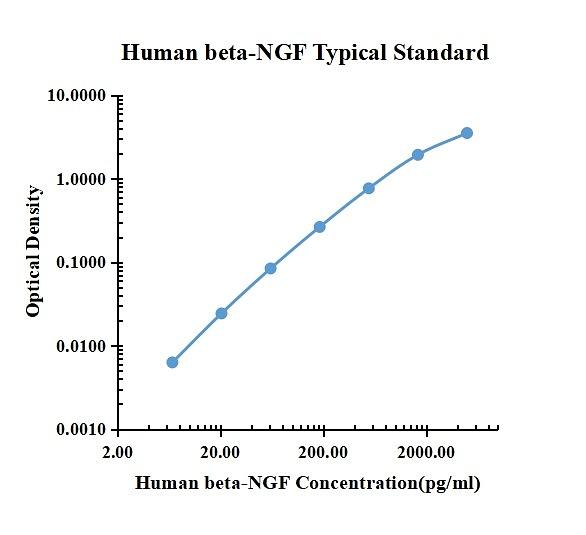Human beta-NGF enzyme-linked immunoassay kit
| Specification | 96 Test |
|---|---|
| Sensitivity | 1.91 pg/ml (50 μl);3.27 pg/ml (10 μl) |
| Standard Curve Range | 6.86~5000 pg/ml |
| Standard Curve Gradient | 7 Points |
| Number of Incubations | 2 |
| Detectable sample | Liquid phase sample of soluble substances. For example: serum, plasma, cell culture supernatant, tissue grinding liquid, etc. |
| Sample Volume | 50 μl/10 μl |
| Type | Fully Ready-to-Use |
| Operation Duration | 120min |

| pg/ml | O.D. | Average | Corrected | |
|---|---|---|---|---|
| 0.00 | 0.0172 | 0.0164 | 0.0168 | |
| 6.86 | 0.0228 | 0.0234 | 0.0231 | 0.0063 |
| 20.58 | 0.0418 | 0.0405 | 0.0412 | 0.0244 |
| 61.73 | 0.1004 | 0.1016 | 0.1010 | 0.0842 |
| 185.19 | 0.2676 | 0.2957 | 0.2817 | 0.2649 |
| 555.56 | 0.7539 | 0.8159 | 0.7849 | 0.7681 |
| 1666.67 | 1.9450 | 1.9640 | 1.9545 | 1.9377 |
| 5000.00 | 3.3400 | 3.7610 | 3.5505 | 3.5337 |
Precision
| Intra-assay Precision | Inter-assay Precision | |||||
| Sample Number | S1 | S2 | S3 | S1 | S2 | S3 |
| 22 | 22 | 22 | 6 | 6 | 6 | |
| Average(pg/ml) | 188.0 | 1692.3 | 2668.5 | 204.0 | 977.6 | 2851.8 |
| Standard Deviation | 11.4 | 74.7 | 142.2 | 11.8 | 43.6 | 106.6 |
| Coefficient of Variation(%) | 6.0 | 4.4 | 5.3 | 5.8 | 4.5 | 3.7 |
Intra-assay Precision (Precision within an assay) Three samples of known concentration were tested twenty times on one plate to assess intra-assay precision.
Inter-assay Precision (Precision between assays) Three samples of known concentration were tested six times on one plate to assess intra-assay precision.
Spike Recovery
The spike recovery was evaluated by spiking 3 levels of human beta-NGF into health human serum sample. The un-spiked serum was used as blank in this experiment.
The recovery ranged from 104% to 132% with an overall mean recovery of 117%.
Sample Values
| Sample Matrix | Sample Evaluated | Range (pg/ml) | Detectable (%) | Mean of Detectable (pg/ml) |
|---|---|---|---|---|
| Serum | 30 | n.d.-17.92 | 87.5 | 7.23 |
Serum/Plasma – Thirty samples from apparently healthy volunteers were evaluated for the presence of beta-NGF in this assay. No medical histories were available for the donors.
Product Data Sheet
Background: beta-NGF
NGF was initially isolated in the mouse submandibular gland as a 7S complex composed of three non-covalently linked subunits, alpha, beta, and gamma. Both the alpha and gamma subunits of NGF are members of the kallikrein family of serine proteases while the beta subunit, called beta -NGF or 2.5S NGF, exhibits all the biological activities ascribed to NGF. Recombinant human beta -NGF is a homodimer of two 120 amino acid polypeptides. The human protein shares approximately 90% homology at the amino acid level with both the mouse and rat beta -NGF and exhibits cross-species activity.
NGF is a well-characterized neurotropic protein that plays a critical role in the development of sympathetic and some sensory neurons in the peripheral nervous system. In addition, NGF can also act in the central nervous system as a trophic factor for basal forebrain cholinergic neurons. NGF has also been shown to have biological effects on non-neuronal tissues. NGF is mitogenic for a factor‑dependent human erythroleukemic cell line, TF-1. NGF has been found to increase the number of mast cells in neonatal rats and to induce histamine release from peritoneal mast cells. NGF will enhance histamine release and strongly modulate the formation of lipid mediators by basophils in response to various stimuli. NGF will also induce the growth and differentiation of human B lymphocytes as well as suppress apoptosis of murine peritoneal neutrophils. These results, taken together, suggest that NGF is a pleiotropic cytokine which, in addition to its neurotropic activities, may have an important role in the regulation of the immune system.

